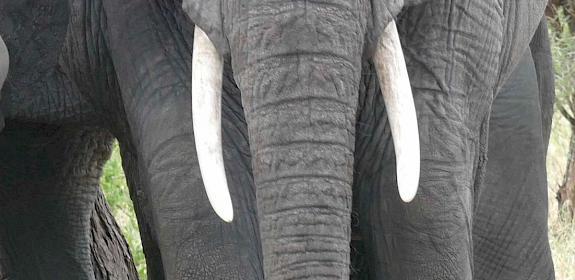US Government destroys store of seized ivory
Denver, USA, 15th November, 2013 —The U.S. Government has publicly destroyed six tonnes of seized African and Asian elephant ivory that had accumulated following enforcement action in the country over the past 25 years. The ivory, which consisted of whole and carved tusks, smaller carvings and other objects, was crushed yesterday at the Rocky Mountain Arsenal National Wildlife Refuge in Denver, Colorado. Federal agency representatives, range State ambassadors, congressional delegations, celebrities and journalists were invited to attend as observers.

According to the U.S. Fish and Wildlife Service, the move to destroy the illicit ivory was aimed at sending a clear message that the U.S. will not tolerate ivory trafficking and the toll it is taking on elephant populations, particularly in Africa.
Crawford Allan, Senior Director for TRAFFIC in America, based in Washington, D.C., congratulates the U.S. for taking this decisive action. “This event has sent a strong message to other countries that action to end the international trade in ivory is of the utmost urgency and that the US is involved in such efforts.” said Allan.
While a full independent audit of ivory to be destroyed would have been ideal, the USFWS has provided documentation of its policies and procedures relating to its inventory of the ivory stockpile, evidence of its storage and chain of custody. Additionally, the USFWS has made it an open and transparent process, allowing many NGOs, media and representatives of other governments access in order to review its secure holding facility and inventory system, as well as capturing the processes in place on video.
TRAFFIC believes that destruction of ivory stockpiles must be preceded by rigorous documentation of the ivory held in stock to ensure that the quantity corresponds to the amount that will be destroyed. Ivory is known to have disappeared from a number of government-held stockpiles worldwide and some unscrupulous authorities have allegedly used the pretence of ivory stock destruction as a means to conceal corruption. “The auditing of ivory stockpiles is essential to ensure that ivory does not find its way into illegal markets prior to being destroyed, further feeding illegal trade”, said Allan. “The US is in a good position to help other countries prevent these ‘leakages’ by providing advice and support to them in strengthening their stockpile control systems.
Allan expressed hope that “the countries that are the main sources and consumer markets for ivory (like the U.S.) ensure that the ivory trade is brought under control with better regulations and enforcement and wider awareness of the impact of the illegal trade in ivory on elephants in Africa”, he said. “The gesture by the U.S. in destroying its seized ivory is a signal of a wider commitment but it will take dozens of countries standing side by side to defeat the criminal networks that are driving the poaching for trade,” he added.
Following this historic event, the U.S. will be working with conservation organizations and other groups to determine how best to use the crushed ivory to increase awareness of the global poaching crisis and signal the U.S.’s commitment to end the international trade in ivory.
In June 2012, following an independent audit by TRAFFIC, WWF and the Gabonese Government, Gabon became the first country in the region to destroy its ivory stocks, thus ensuring that all tusks were accounted for and none had leaked into illegal trade.
The international ivory trade was banned in 1989 under the Convention on International Trade in Endangered Species of Wild Fauna and Flora (CITES). According to the ETIS (Elephant Trade Information System) report presented to Parties at CoP16, elephant poaching has been on the rise and in 2012 was at its worst in a decade.




